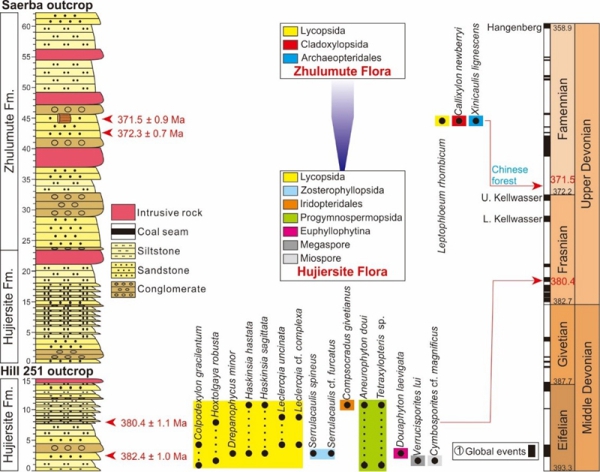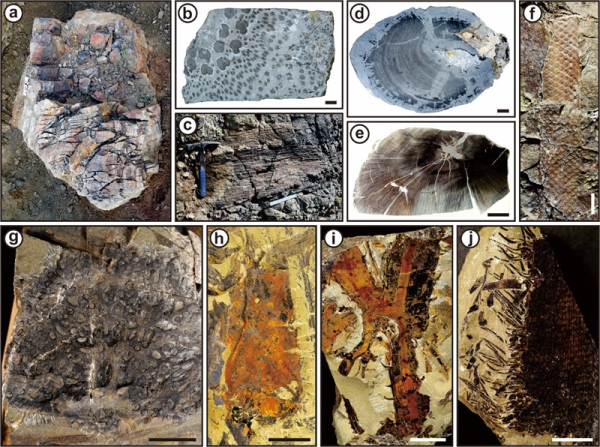As one of the five major extinction events in Earth history, the Frasnian-Famennian boundary (FFB) crisis caused dramatic reductions in marine and terrestrial diversity. The effects of this event on terrestrial ecosystems are not well understood due to the limited preservation of terrestrial sedimentary rocks and the relative scarcity of plant fossils. Besides, the stratigraphic position of the FFB remains tentative.
In the past years, and Prof. XU Honghe, the group members of from the ‘Modern terrestrial ecosystem origin and early evolution’ of Nanjing Institute of Geology and Palaeontology, Chinese Academy of Sciences, and Dr. ZHENG Daran from The University of Hong Kong, has made detailed investigations for several Devonian terrestrial outcrops in West Junggar, northwestern China. Related results were published online in the international geoscience journal Palaeogeography, Palaeoclimatology, Palaeoecology.
They provide a robust zircon U-Pb age (371.5 ± 0.9 Ma; earliest Famennian) for a new fossil assemblage containing Lycopsida, Archaeopteridales, and Cladoxylopsida from the upper Zhulumute Formation of the West Junggar Basin, NW China. These taxa are typical arborescent plants of the Late Devonian and represent the oldest-known forest in China, documenting afforestation in West Junggar coevally with or just after the Upper Kellwasser event (~372 Ma). The new U-Pb ages generated in this study refine the placement of the FFB in West Junggar to within the Zhulumute Formation, instead of the Hongguleleng Formation as previously thought.
In the study area, the Upper Devonian Zhulumute Formation contains at least three types of potentially forest-forming plants: the arborescent lycopsid L. rhombicum, the archaeopteridalean progymnosperms C. trifilievii and C. newberryi, and the cladoxylopsid X. lignescens. Although the floral assemblages of the lower Famennian Zhulumute Formation do not represent in-situ growth, the presence of abundant arborescent taxa is inferred to represent the earliest known forest in the West Junggar region. These fossil assemblages show the same taxonomic composition as those confidently ascribed to Late Devonian forest ecosystems elsewhere globally.
It is significant that the early Frasnian Hujiersite and early Famennian Zhulumute floras contain no duplicate members. The elevation differences probably cause the different components of two floras. The present radiometric results constrain this floral transition to a ~9 to 11-Myr window between the Hujiersite Flora (maximum depositional ages 382.4 ± 1.0 Ma to 380.4 ± 1.1 Ma and the Zhulumute Flora (maximum depositional age 371.5 ± 0.9 Ma). Thus, our results are permissive of the possibility that this transition, although not tightly age-constrained, coincided with the Upper Kellwasser Event (~372-374 Ma).
In West Junggar, the stratigraphic position of the FFB remains tentative. The FFB was controversially interpreted to occur in the lower part of the marine Hongguleleng Formation. Numerous studies have debated the age of the Hongguleleng Formation. Its conodont biostratigraphy has been interpreted as Famennian, late Frasnian–Famennian, or Famennnian–Tournaisian in age. At Bulongguoer, the FFB was placed 2.7 m above the base of the marine Hongguleleng Formation, but not without controversy. At Saerba, the 371.5 U-Pb ages of the present study favor FFB placement within the Zhulumute Formation. Strata of the upper Zhulumute Formation at Bulongguoer and Saerba are considered to be correlative based on similar lithologies and finds of Leptophloeum rhombicum and Callixylon newberryi. This interpretation differs from long-held interpretations regarding placement of the FFB in NW China. Specifically, our age data indicate that the FFB is present in the terrestrial Zhulumute Formation and not within the marine Hongguleleng Formation.
Together with paleontological evidence, this new chronostratigraphic constraint indicates that forest development occurred synchronously with or immediately following the Upper Kellwasser crisis in West Junggar. These findings are consistent with the possibility of a major floral turnover at the FFB, although further investigation will be required to test this hypothesis.
This research was supported by the Strategic Priority Research Program of Chinese Academy of Sciences, the HKU Seed Fund for Basic Research, and National Natural Science Foundation of China.
Reference: Zheng, D.R., Chang, S.C. *, Algeo, T., Zhang H.C., Wang, B., Wang, H., Wang, J., Feng, C.Q., Xu, H.H.*, 2020. Age constraint for an earliest Famennian forest and its implications for Frasnian-Famennian boundary in West Junggar, Northwest China. Palaeogeography, Palaeoclimatology, Palaeoecology, 552, 109749. https://doi.org/10.1016/j.palaeo.2020.109749

Figure 1. Field photo of the Saerba Section of the Zhulumute Formation in West Junggar, Xinjiang, China

Figure 2. The turn-over and the geological ages of the Middle to Late Devonian flora of West Junggar, Xinjiang, China

Figure 3. Representative Frasnian-Famennian fossil plants in West Junggar, Xinjiang, China
Download:
